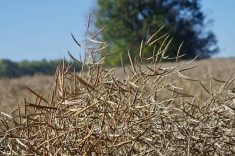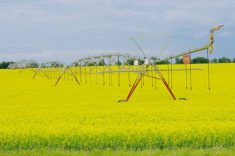ICE Futures Canada canola contracts saw some very choppy activity during the week ended March 18, hitting their lowest levels in months at one point before recovering to end the week with modest gains.
News out of Japan dominated the headlines in all of the global financial and commodity markets, and canola was no exception. The threat of a nuclear meltdown understandably gets people worried, and those concerns led to a sharp speculative sell-off as investors ditched their riskier holdings. However, just as fast as canola prices dropped, they bounced back up, with the losses triggering some end-user buying.
Read Also

Manitoba sclerotinia picture mixed for 2025
Variations in weather and crop development in this year’s Manitoba canola fields make blanket sclerotinia outlooks hard to pin down
Forthree-times-dailymarket reportsfromCommodityNews ServiceCanada,visit“ICE FuturesCanadaupdates”at www.manitobacooperator.ca.
Japan is normally a steady customer for Canadian canola, purchasing about 1.9 million to 2.1 million tonnes annually. In the aftermath of the disaster, ports and processing plants in Japan were closed, and the extent of the damage to canola-processing facilities is still unknown. The general consensus among analysts now is that shipping disruptions are to be expected in the near term, but in the longer term Japan will still need to import food. Depending on the extent of the damage to Japan’s crushing plants, those imports as far as canola is concerned could shift away from bulk seed to already processed oil.
If the crisis in Japan wasn’t enough to keep traders on edge, international attention also remains focused on the ongoing unrest in North Africa and the Middle East. International forces, including Canada’s, were mobilizing to put a stop to civil war in Libya, and over the weekend the U.S. pounded the country with more than 100 cruise missiles. Oil makes the world go round and as long as the threat of disruption to oil supplies remains in place, choppiness should be expected to persist in global financial, energy and commodity markets.
Soybeans, corn and wheat futures in the U.S. also saw some large price swings during the week, with the Japanese and Libyan news providing a backdrop to the wild activity.
The ebb and flow of speculative money, tied to global economic and political issues, will remain a factor in the grain and oilseed markets, but the ebb and flow of a different nature can be expected to take precedence in the weeks ahead.
U.S. farmers in the southern delta region begin seeding in late March, and planting operations will move steadily north from there through April and into May. The question now is whether U.S. farmers will plant enough corn and soybeans this spring to alleviate the tight supply situation, especially as concerns mount that spring flooding could limit some acres.
ACRES AT RISK
The U.S. National Oceanic and Atmospheric Administration (NOAA) put out a report during the week suggesting up to half of the U.S. grain belt could be at risk of flooding this spring. The Red River Valley in North Dakota and Minnesota could be particularly hard hit, and we know here in Manitoba that all that water will eventually be flowing north.
U.S. farmers plant corn before soybeans, and any seeding delays could see acres shift from longer-season corn into soybeans, which can fare relatively well in moist conditions. Supplies of both commodities are tight, and that acreage battle will remain in place until everything is in the ground. In addition, the wet weather will inevitably lead to quality concerns, which could prop up values as well through the growing season.
That’s the issue right now in Brazil, where heavy rains at harvest time have created some problems with the soybean crop. The wet weather in South America has also led to some delays moving product, heightening the strain on already-tight U.S. supplies.
Looking back to Canada, in addition to the expected flooding in southern Manitoba, large portions of Saskatchewan could also be too wet to seed in a timely manner this spring. High prices and the relative ease of growing the crop should keep canola as a top contender for acres, but in any case weather issues will be a major factor going forward. At the same time, the past week has also shown that none of the agricultural commodities operate in a bubble. And that means international headlines will continue to dictate the direction in the markets as well, with the same news sometimes construed as bearish, and other times as bullish, depending on the interpretation that day.
Phil Franz-Warkentin and Dwayne Klassen write for Commodity News Service Canada,
a Winnipeg company specializing in grain and commodity market reporting.


















